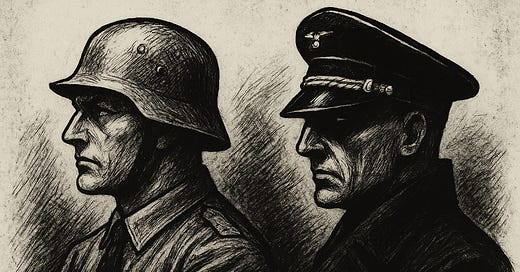(link to previous essay at the end)
I chose to draw a parallel with the Nazi stormtroopers (Sturmabteilung, pronounced SHTOORM-ahp-tie-loong, or SA) rather than the Gestapo for a reason. Both were tools of authoritarian control in the Hitler era—but they operated differently, and the distinction matters in my choice.
The SA were a loud, visible paramilitary street force, active primarily from 1921 through the mid-1930s, and designed to intimidate in public. In practice, their core mission was to protect and promote the Nazi Party through street-level violence, suppression of political opponents, and theatrical displays of power—laying the groundwork for the Nazi takeover of the German state. They patrolled rallies, beat adversaries in the streets, and used spectacle to silence dissent. Their goal was to create fear not through secrecy, but through open confrontation. Though not part of the formal state apparatus at first, the SA blurred the line between party loyalists and law enforcement, helping dismantle democratic norms from the outside in.
The SA originated in 1921 as the Nazi Party’s original paramilitary wing, answering to Adolf Hitler and Ernst Röhm. By the early 1930s, they had grown to millions of members and became a powerful political force. But their independence and thuggish tactics threatened Hitler’s control. In 1934, during the Night of the Long Knives, Hitler ordered a violent purge—killing—of the SA leadership, including Ernst Röhm, shifting power to the SS (Schutzstaffel) and sidelining the SA permanently. The group remained in existence through WWII, but its influence collapsed after 1934.
The Gestapo, by contrast, was a secret police force—silent, bureaucratic, and embedded within the state. It operated behind closed doors, relying on surveillance, informants, and covert arrests. Its power was rooted in invisibility, not public terror.
The Gestapo was founded in 1933 by Hermann Göring in Prussia and quickly expanded under Heinrich Himmler’s SS. It merged with other state security forces and became a pillar of Nazi totalitarianism. While small in size, the Gestapo used vast informant networks and unchecked power to eliminate political dissent and enforce Nazi racial laws. It remained active throughout the Nazi regime and was declared a criminal organization at the Nuremberg Trials in 1945.
The point of invoking the SA is that authoritarian movements often begin with visible enforcement thugs—agents of chaos operating under a veneer of legitimacy. When ICE agents in tactical gear conduct raids in working-class neighborhoods, when masks are used to obscure identity and avoid accountability, when the purpose becomes intimidation over immigration enforcement—that is not yet the Gestapo. It is Sturmabteilung logic.
This is why I draw the line to the Sturmabteilung. Not because we are living in 1930s Germany, not because the SA was identical to ICE, and not to predict that ICE will meet the same fate as the SA during the Night of the Long Knives—but because the behavior of our government, and their use of ICE, increasingly resembles the SA in no uncertain terms. We’re watching the rhymes of history begin.
⸻
What Was the Night of the Long Knives?
The Night of the Long Knives was a violent three-day purge carried out from June 30 to July 2, 1934, ordered by Adolf Hitler to eliminate internal threats to his control. The primary targets were the leaders of the SA (Sturmabteilung), including its chief, Ernst Röhm, who had grown too powerful and openly challenged the regular army’s authority.
Hitler, fearing a potential coup and eager to win the loyalty of the German military, ordered the SS (Schutzstaffel)—then a smaller, elite faction loyal to Heinrich Himmler—to arrest and execute Röhm and dozens of other SA leaders. Several conservative critics of Hitler outside the SA were also killed.
The purge was retroactively legalized by the Nazi regime and largely accepted by the German public. It marked a major turning point in Hitler’s consolidation of power:
• The SA was politically neutered and relegated to a secondary role.
• The SS rose to dominance, becoming the regime’s main instrument of terror.
• The German military (Reichswehr) pledged loyalty directly to Hitler shortly after, cementing his absolute control.
The event demonstrated how authoritarian regimes often turn inward, purging their own enforcers once they’ve outlived their usefulness. It also makes clear that ICE and the SA are not “history repeating”—but rather, “history rhyming.”
Previous essay:
ICE: America’s Stormtroopers
Under an authoritarian regime, ICE stops functioning as a neutral immigration agency and becomes something darker: an American echo of the stormtroopers—not in uniform or name, but in purpose.





Thanks Clyde. Useful reading. I appreciate the citations.